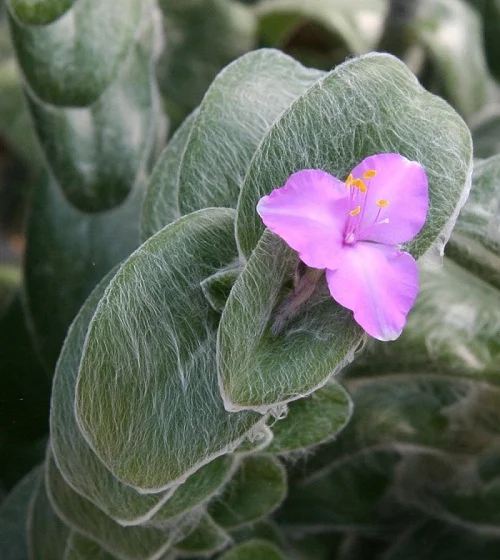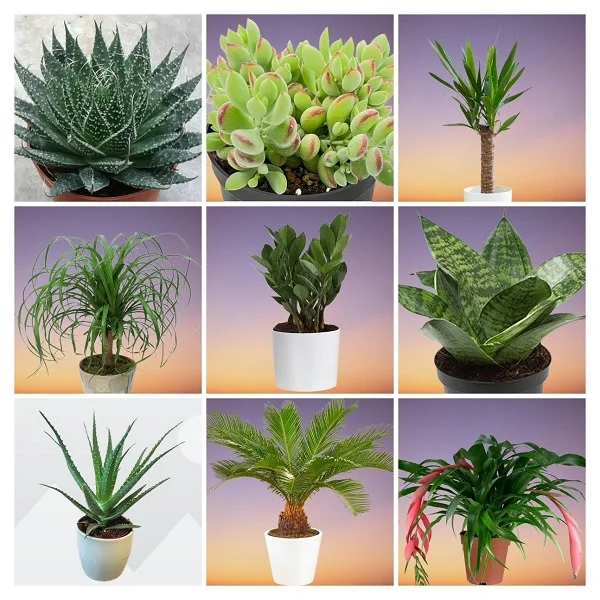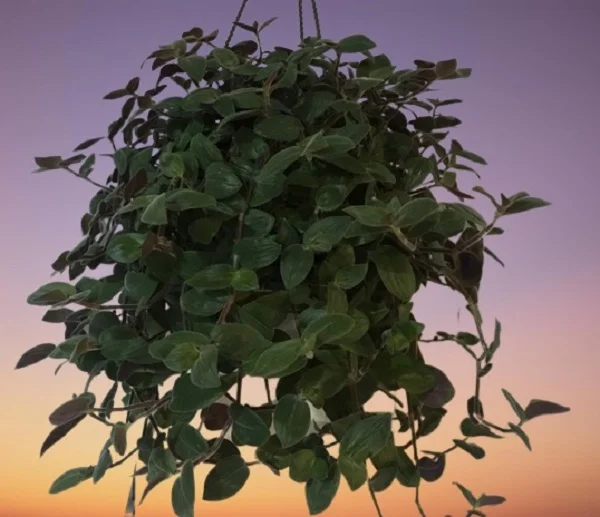Tradescantia sillamontana (Cobweb Spiderwort) Care Indoors, Propagation & Problems
Some links in this post may be affiliate links
Tradescantia sillamontana (Cobweb Spiderwort) thrives in bright indirect light, average warmth, moderate humidity and moderately moist, rich, free-draining soil coupled with monthly feeding in the growing season.
Cobweb Spiderwort is a tough yet charming plant and can handle a bit of neglect, making it perfect for busy plant parents. Let’s dive into some facts about this plant.
Tradescantia sillamontana also called White Velvet Plant or White Gossamer Plant is one of the compact, upright Tradescantia varieties and bears highly branched hairy stems.
White Velvet Plant leaves are oblong-lanceolate and are in the shape of a boat's keel and may have a purple tone. The flowers are borne at the end of the stems and are a deep pink color.
The entire Cobweb Spiderwort houseplant is covered by white hairs and hence the common names. It grows to a height of about 1 foot. It is among the best small low light plants for the indoors.
White Gossamer Plant exhibits upright growth in the early stages of development but as it matures it exhibits prostrate growth and rooting at the soil surface.

Botanical name: Tradescantia sillamontana
Family: Commelinaceae
Common names: Cobweb Spiderwort, White Velvet Plant, White Gossamer Plant
Origin
Tradescantia sillamontana is endemic to dry areas of the State of Nuevo Len in northeastern Mexico and can also be found in Spain and Italy.
Is Cobweb Spiderwort toxic to pets?
Yes. Tradescantia sillamontana is mildly toxic to humans and pets. If ingested, the plant sap can cause burning in the mouth, tongue and throat. It may also cause skin irritation in sensitive skin; always wear gloves when handling the plant.
Why grow Cobweb Spiderwort indoors?
- Low maintenance: It is hardy and adapts well to indoor growing conditions.
- Drought-resistant: It stores water in its stems and leaves.
- Fast-growing & trailing: Makes it perfect for hanging baskets or as a ground cover in larger pots.
- Fuzzy, unique look: The velvety, silver-green leaves with a cobweb-like texture are unlike any other houseplant.
Where to Buy
Are you looking to add Cobweb Spiderworts to your collection? You may get them online from Etsy (Link to Etsy).
Tradescantia sillamontana Care Indoors
To care for Tradescantia sillamontana indoors, provide bright indirect light, average warmth of 16-270C, moderate humidity of 50-55% and moderately moist, fertile, well-drained, succulents mix coupled with monthly feeding during the growing season.
Cobweb Spiderwort care requires repotting only when extremely pot-bound as it grows best when slightly root-bound. Regular pruning is needed to keep it neat, to reduce pest and disease infestations, to encourage a bushy, compact growth and to rejuvenate growth. Keep reading for more on these growing conditions and how to achieve them.

Watering
Tradescantia sillamontana is semi-succulent; it stores water in its leaves and doesnot need too frequent watering.
Water your Cobweb Spiderwort liberally in spring and summer and allow the top 2-3 inches of soil to dry out between waterings. Maintain the soil moderately moist but not soggy; too much water can cause yellow leaves and mushy stems.
Decrease watering in fall and winter to keep the soil slightly moist as growth is minimal. Do not allow the soil to dry out completely to avoid wilting and drooping leaves.
Ensure that the pot has a drainage hole to prevent the soil from getting soggy soil as it can lead to root-rot and death of the plant.
Light Requirements
Cobweb Spiderwort grows best in bright indirect light (dappled light). Keep it away from direct sunshine as it can cause scorching; crispy or bleached leaves.
Too low light will result in slow growth and dark-green leaves. Move the Tradescantia sillamontana to a brighter location or use a grow light where the natural light is inadequate.
Regularly rotate the pot to ensure that the plant receives light on all sides for even growth and avoid lopsided growth.
Temperature and Humidity
Cobweb Spiderwort is a warm-weather plant and does well in average warmth of 16-270C. A room temperature that is comfortable for you is ideal for this plant.
Keep it away from drafts as they can lead to sudden changes in the temperature which can cause reduced growth and leaf drop.
Tradescantia sillamontana flourishes in a humidity of 50-55%. However, if the air is too dry, set the pot on a wet pebble tray or use a humidifier to raise humidity. Make sure that there is proper circulation to reduce fungal diseases.
Fertilizer
Feed Cobweb Spiderwort with a balanced, liquid fertilizer every 4 weeks in spring and summer to promote a lush growth. Stop feeding in the fall and winter as the growth is minimal and feeding at this time may lead to fertilizer burn; browning of leaf edges and tips.
Potting Mix
Cobweb Spiderwort soil should be a fertile, well-draining, sandy soil mix to avoid waterlogging while providing the required nutrients. Most cactus and succulents potting mixes are ideal for this plant.
Repotting
Repot Cobweb Spiderwort during the growing season only when the plant has become extremely pot-bound as it grows best when the roots are confined.
Use a pot one size larger than the current one and ensure that the pot has a drainage hole to prevent the soil from getting soggy as it can lead to root-rot. Take a look at these succulents pots available on Amazon.
Pruning & Grooming
Pruning Cobweb Spiderwort involves regular removal of dead foliage to maintain the plant neat as well as discourage pest and disease infestations.
To control the growth and encourage bushyness, pinch the growing tips. Cutback leggy stems at the beginning of the growing season to rejuvenate growth.
Clean the leaves occasionally with a soft brush to keep them clean as well as discourage pest and disease infestations.
Tradescantia sillamontana Propagation
Tradescantia sillamontana (Cobweb Spiderwort) propagation is done by plant divison or from stem cuttings in spring to early summer when in active growth.
1. Cobweb Spiderwort propagation by plant division
- Water the plant thoroughly at least 1 day before to make it easier to divide and also hasten establishment.
- Slip the plant out of its pot and carefully divide it into sections. Ensure each sections has adequate roots and at least one set of leaves.
- Select a 6 or 8 inches pot and ensure that the pot has a drainage hole to prevent the soil from getting soggy as it can lead to rotting.
- Fill the pot with loose, free-draining soil and make a hole in the center of the pot. Ensure that the hole is slightly wider than the root base of the section.
- Place the section in the previously made hole and lightly firm the soil around the base while taking care not to bury it too deep; maintain the section at the same soil level it was in the previous pot.
- Water the soil thoroughly and place the set up in a well-lit, warm place until the new plant is well established after which you can begin routine care.
2. Cobweb Spiderwort propagation from stem cuttings
The stem cuttings root easily so there is no need for rooting hormone.
- Take a stem cutting of about 4-6 inches from a healthy plant and ensure it bears at least two sets of leaves.
- Allow some time for the formation of a protective callus tissue over the cuts of the cuttings to prevent rotting.
- Fill the rooting container with loose, free-draining soil to a depth of about 4 inches. Lightly moisten the soil.
- With a pencil or similar object make a hole that is wider than the diameter of the cutting. Carefully insert the cutting in the hole made previously to a depth of about 3 inches.
- Place the set up in a warm, well-lit place and maintain the soil moist through out until new growth emerges.
- Allow the new plants to be well established before transplanting to individual pots after which you can begin routine care.

Tradescantia sillamontana Problems & Solutions
Cobweb Spiderwort problems are yellow leaves, brown leaves, plant dying, leggy growth, pests and diseases among others. Keep reading for more on these problems and how to fix them.
Yellow leaves
The main causes of yellow leaves on Cobweb Spiderwort are overwatering, soggy soil, nutrient deficiency, and temperature stress.
How to fix it
Overwatering: Do not water on a schedule. Water only when the top 2-3 inches of soil dry.
Soggy soil: Use a well-draining potting soil and a pot that has a drainage hole.
Nutrient deficiency: Apply a balanced, water-soluble fertilizer every 4 weeks in spring and summer.
Temperature stress: Keep the plant away from drafts coming from hot surfaces, hot air vents, AC units, windy doors among others.
Brown leaves
Some of the causes of brown leaves on Tradescantia sillamontana are inconsistent watering, soggy soil, and temperature stress.
How to fix it
Inconsistent watering: Do not water on a schedule. Water when the top 2-3 inches dry out. Never allow the soil to dry out completely.
Soggy soil: Use a pot that has a drainage hole and free-draining soil.
Temperature stress: Keep the plant away from drafts emanating from AC units, drafty windows, heat sources, windy doors and others.
Plant dying
Cobweb Spiderwort plant is dying due to root-rot disease which is promoted by soggy soil. It is characterized by yellowing and wilting leaves, rapidly followed by browning and plant collapse.
How to fix it
- Carefully slip the plant out of its pot and inspect the roots.
- Trim the brown-black, mushy roots and treat the healthy roots with a copper-based fungicidal solution as indicated by the manufacturer.
- Disinfect the pot with the fungicidal solution or use a fresh pot to repot the plant in fresh, free-draining soil.
- Do not water the plant immediately and keep it dry for 5-7 days before you can resume watering.
- Lessen watering in fall and winter as growth is slowed at this time; keep the soil slightly moist.
Leggy growth
Leggy growth on Tradescantia sillamontana is due to too little light, underwatering or nutrients deficiency.
How to fix it
Too little light: Move the plant to a brighter spot where it will receive bright indirect light or instal grow lights if the natural lighting is not sufficient.
Underwatering: Water when the top 2-3 inches of soil dy out but do not allow the soilball to dry out completely.
Nutrients deficiency: Feed the plant once a month in spring and summer with a balanced, liquid fertilizer.
Pests
Common pests on Cobweb Spiderwort are mealybugs, aphids and scale insects.
How to fix it
- Isolate the affected plant to prevent spread to the other plants.
- Treat the infected plant with neem oil or insecticidal soap as per the manufacturers instructions.
- Regularly check underneath the leaves for these pests and carry out timely control measures.
- Maintain the plant properly pruned and raise humidity to discourage pest infestation.
Diseases
Cobweb Spiderwort is prone to leaf spot disease which is prevalent in overwet conditions coupled with poor air circulation. It presents as brown, watery leaf spots.
How to fix it
- Remove and discard the affected parts to reduce the risk of spread to the rest of the plants.
- Isolate the affected plant and treat it with horticultural oil as per the manufacturer's instructions.
- Keep the plant on the dry side, do not mist it and do not wet the foliage druring water or water from the bottom.
- Use a pot with a drainage hole and well-draining soil.
- Improve air circulation to discourage the occurence of the disease.
Conclusion
Tradescantia sillamontana is a low-maintenance, fuzzy-leaved beauty that’s perfect for indoor gardening. Whether you grow it in a hanging basket or pot, this resilient plant adds character and charm to any space. By following these care tips, you can enjoy a healthy and thriving Cobweb Spiderwort.
Frequently Asked Questions
1. How much sunlight does Cobweb Spiderwort need?
Cobweb Spiderwort thrives in bright indirect light, but can handle some direct morning sun.
2. How often should I water Cobweb Spiderwort?
Water Cobweb Spiderwort only when the top 2-3 inches of soil dry out.
3. Can Cobweb Spiderwort grow in low light?
Cobweb Spiderwort can survive in moderate light but will become leggy and weak. For best results, place it in bright, indirect light.
4. Can I grow Cobweb Spiderwort outdoors?
Yes. Cobweb Spiderwort will thrive in warm, frost-free climates as a ground cover or container plant.
5. How fast does Cobweb Spiderwort grow?
Cobweb Spiderwort has a moderate to fast growth rate, especially in warm months.
You liked it? Share on social media.
Related Content
Amazon Associates Disclosure
Homeplantsguide.com is a participant in the Amazon Services LLC Associates Program, an affiliate advertising program designed to provide a means for sites to earn advertising fees by advertising and linking to amazon.com.




